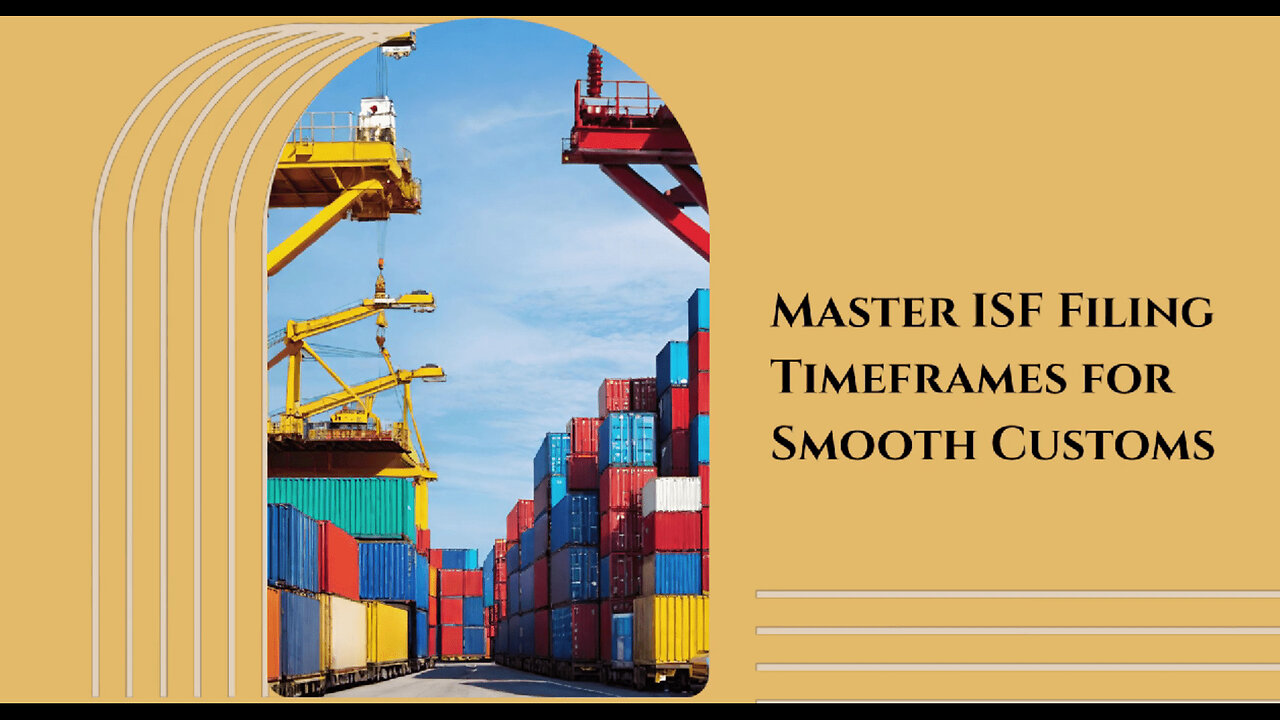Premium Only Content

Mastering ISF Timeframes: Key to Smooth Customs Clearance and Compliance!
ISF Filer || [email protected] || 858-280-9374 || www.isffiler.com
Importing goods into the United States requires various documentation and filings, with the Importer Security Filing (ISF) being one of the most important. In this video, we will explore the essential timeframes for ISF filings and discuss the implications of these timeframes on customs clearance and compliance.
The ISF filing must be submitted to U.S. Customs and Border Protection (CBP) before the cargo is loaded onto the vessel, ensuring that the required information is provided in a timely manner. To ensure increased security in international trade, the CBP implemented the 10+2 rule, which requires importers to provide 10 data elements and carriers to submit 2 additional data elements.
According to CBP regulations, the ISF filing must be transmitted at least 24 hours prior to the vessel's departure from the foreign port. It is important to note that this timeframe applies to the filing transmission, not the cargo loading. This allows customs officials to review the information and identify any potential security risks before the vessel arrives at the U.S. port.
Once the initial ISF filing is submitted, it is crucial to promptly make any necessary amendments or updates. These amendments may include changes to cargo quantity, shipper or consignee details, or any other relevant information. By ensuring accurate and up-to-date information, you can avoid penalties that may be imposed for late or incorrect filings.
In situations where the 24-hour timeframe cannot be met, it is essential to communicate with the CBP as soon as possible and explore potential solutions. Late filings can result in penalties, cargo holds, or additional inspections, which can lead to costly delays and disruptions in the supply chain.
It is important to note that there is an exception to the general 24-hour timeframe for ISF filings. In immediate exportation (IE) scenarios, the ISF filing becomes due before the arrival of the vessel carrying the merchandise. This exception allows for more flexibility and ensures that time-sensitive shipments can still be processed efficiently.
Understanding and adhering to the essential timeframes for ISF filings is crucial for successful and compliant customs operations. By submitting the ISF filing at least 24 hours prior to the vessel's departure, making timely amendments, and communicating with the CBP, you can ensure a smooth customs clearance process. It is important to stay informed about any updates or changes in the regulations to avoid penalties and delays. Thank you for watching, and stay tuned for more informative videos on customs brokerage and international trade.
#usimportbond #isfcustomsbroker #uscustomsclearing #isfentry
Video Disclaimer Here: This video is intended for educational purposes and has no affiliation with US government entities.
-
 UPCOMING
UPCOMING
The Robert Scott Bell Show
1 hour agoLive From CHD Austin Texas, Kids Triple Vaccinated, Blood Sugar and Autism, Candy Fed to Cows, Nutrition Reform - The RSB Show 11-7-25
2 -
 1:15:58
1:15:58
DeVory Darkins
1 hour agoLIVE NOW: Democrats SABOTAGE GOP effort to reopen Government
26K31 -
 1:21:21
1:21:21
Tucker Carlson
1 hour agoThe Global War on Christianity Just Got a Whole Lot Worse, and Ted Cruz Doesn’t Care
4.96K62 -
 10:50
10:50
Dr. Nick Zyrowski
2 days agoDoctors Got It Wrong! This LOWERS CORTISOL In Minutes!
8362 -
 24:14
24:14
Verified Investing
2 days agoBiggest Trade As AI Bubble Begins To Burst, Bitcoin Flushes Through 100K And Gold Set To Fall
25 -

Sean Unpaved
1 hour agoAB's Dubai Drama: Extradited & Exposed + NFL Week 10 Locks & CFB Week 11 Upsets
2.79K -
 2:06:08
2:06:08
The Culture War with Tim Pool
3 hours agoDemocrats Elect Man Who Wants To Kill Conservatives, Time For An Exorcism | The Culture War Podcast
89.2K82 -
 1:36:52
1:36:52
Steven Crowder
4 hours agoMamdani's Anti-White Victory Must Be America's Wake Up Call
226K258 -
 LIVE
LIVE
Dr Disrespect
4 hours ago🔴LIVE - DR DISRESPECT - ARC RAIDERS - AGAINST ALL DANGER
1,503 watching -
 LIVE
LIVE
Side Scrollers Podcast
3 hours agoGTA 6 GETS WRECKED AFTER ANOTHER DELAY + India THREATENS YouTuber Over Video + More | Side Scrollers
905 watching